Wedge Analysis of Seismic Pressure (WASP)
Retaining walls and other structures with imbalanced earth pressure are commonly designed to resist seismic pressures that will develop during earthquakes. One of the main methods to determine the seismic pressure is the Mononobe-Okabe equation, which was developed in 1926 to 1929, and which has been referenced widely in codes.
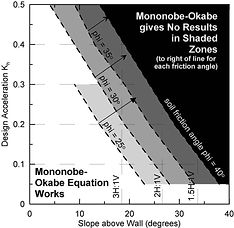
A shortcoming of the Mononobe-Okabe (M-O) method is that it does not produce a result for moderate to high design accelerations when there is even a moderate slope above a retaining wall. In these cases the equation develops a negative term inside a square root, so results above a certain level result in imaginary numbers. The graph below shows shaded zones, where, for the indicated soil friction angle, the M-O equation does not work.
For example, in the Reno Nevada area, the peak design acceleration is about 0.6g (for AASHTO, higher for International Building Code 2009), which means that the input acceleration into Mononabe-Okabe is half that or 0.3g for cantilever retaining walls. The equation does not work for slopes steeper than 3.0H:1V and leaves the designer without a solution for what the seismic earth pressure should be. These situations are more common in the Western U.S. due to the increased seismic loads in the 2012 International Building Code.
WASP is a low cost, simple force equilibrium program that can provide the same pseudo-static seismic active earth pressure as Mononobe-Okabe including solutions where Mononobe-Okabe cannot, and also provide means to evaluate the active earth pressure including cohesion and several other parameters.
There are a number of published papers which dispute or have modifications to the pseudo-static analysis approach, we discuss these on the Mononobe-Okabe page under the heading "Nay Sayers."
Why Buy WASP
The WASP program is intended for engineers with a solid geotechnical understanding in order to develop active or earthquake active pressures in high-seismic areas. The program is also useful for structural engineers provided that geotechnical parameters (unit weight, cohesion, friction angle) are specified by the geotechnical engineer or by soil testing. Specifically, you would benefit from WASP if
1) We are licensing WASP yearly for $85. At that price, generally less than one hour of professional billing, its relatively easy to justify expensing the use of the program to a specific project.
2) You are designing retaining walls in high-seismic areas (design ground acceleration in the range of 0.3 to 0.4 g or higher, kh = 0.15 to 0.2 or higher) or with uphill slopes where Mononobe-Okabe does not work. Modern codes (i.e. IBC 2003 on) are requiring lower probabilities of earthquake shaking with higher accelerations which are more likely to fall outside the range of the Mononobe-Okabe equation.
3) You are designing retaining walls in soils with slight to moderate cohesion. The use of even a small amount of cohesion (50 to 200 psf, 2.5 to 5 kPa) in either native soils or compacted backfill can reduce the active earthquake pressure coefficient. (NOTE the program can estimated small or zero Ka [If you use a seismic coefficient of zero it produces the same results as Coulomb or Rankine equations] which may be inappropriate for static wall design, where at least a conventional minimum positive value should be used).
4) The program includes estimation of predicted wall seismic deformation (based on Franklin and Chang, 1977) that, if the project or owner can accept a higher level of deformation, can allow design for a lower horizontal coefficient and therefore a lower active pressure.
5) The program allows evaluation of the active coefficient distribution at all wedge angles, not just at the critical wedge angle producing the maximum value. This can be useful if you are designing a wall with retained soil that is limited by bedrock or previous soils slopes, and also provide better information on the required unbonded length of tiebacks.
6) The program allows evaluation of certain situations where the wedge length will be limited, such as due to an adjacent self-retained adjacent building foundation or adjacent retaining wall, which may allow a reduction in the active earthquake pressure.
7) You are back-analyzing wall performance from actual earthquakes where short-term cohesion (possibly including capillary rise) may have been present.
8) The WASP program is a force-equilibrium solution of the soil wedge behind a retaining wall. Therefore its fundamantals are relatively simple and understood; it exceeds the analysis requirements for wedge analysis in NCHRP Report 611, and exceeds the requirements for trial wedge analysis in FHWA 2011 (LRFD Seismic Analysis and Design of Transportation Geotechnical Features and Structural Foundations). It matches Mononobe-Okabe, Coulomb and Rankine equation for all situations where the latter equations can be calculated. If you own a multi-slope force equilibrium solutions already, (e.g. Civil Tech Shoring) you do not need this program, however most of these solutions cost considerably more. You can also use a standard slope stability program (SLIDE, SLOPE/W) however in our experience that takes considerably more steps and will take 1/2 to 1 hour to complete.
Screen Shots
The program input and output are present on several tabs the same page, and results are updated immediately as new values are entered. The geometry of the critical failure surface and the distribution of potential active pressures for various angles is shown on the graph as changes are made.
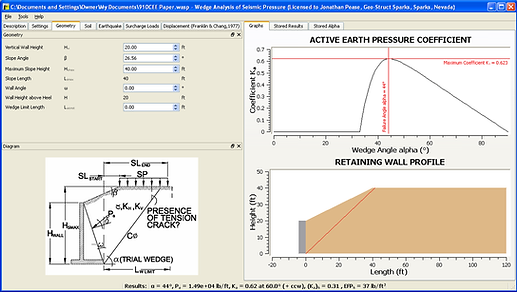
In additional to friction angle in Mononobe-Okabe or Mohr-Coulomb, soil properties include unit weight (only makes a difference in results if cohesion or surcharge loads are added), cohesion, and whether or not to include a tension crack. The tension crack generally increases the active pressure coefficient slighlty.
Note that the program computes Kae as the total earth load divided by gamma*H^2, same as for without cohesion, it does not consider a tensile zone at the top of the wall. The results bar at the bottom includes Pae, in case you want to compute Kae your way. While a tension crack at the top of the wall seems logical for long-term design cases, we would think that during seismic shaking, the crack would only be at the back of the wedge.
As seen on this picture, the program supports Metric as well as English units.
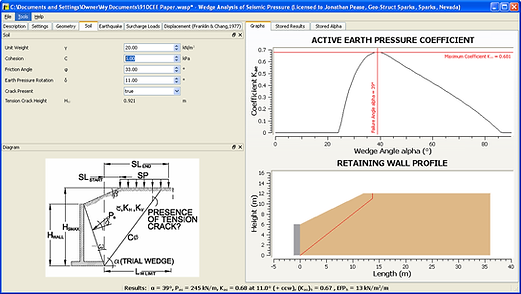
We presently support one horizontal load (line load) and one vertical surcharge load. We recommend this more to provide you a method to assess interaction (will the sliding resistance from the base of a retaining wall 20 feet away and 10 feet higher cause the critical failure surface to interact with that load, or is it far enough back?, is a building foundation at the top of the slope far enough away to avoid interaction?) rather than to determine the earthquake active pressure that would be provided for design to a structural engineer. This diagram shows that a row of tiebacks (possibly features prior to wall construction) at 15 feet back from the wall reduce the Kae by making the critical angle steeper (from 35 to 45 degrees).
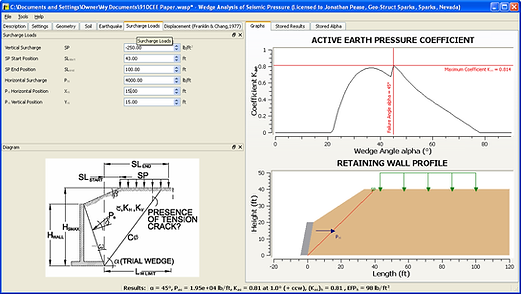
Output includes a single page output that is basically a screen shot of the program with all the input tabs showing.
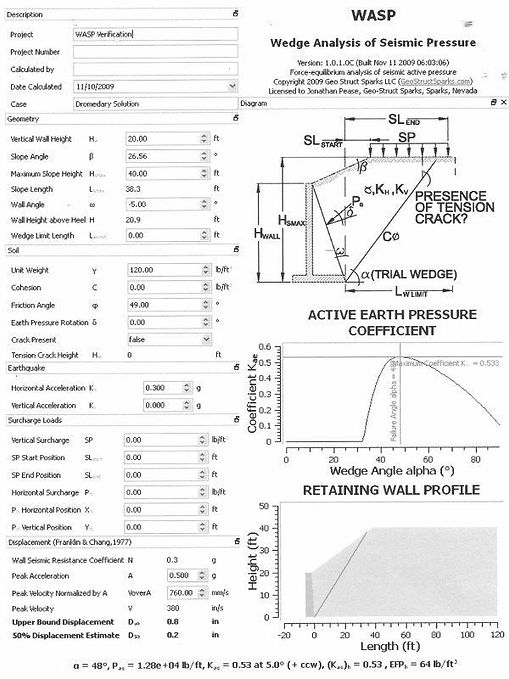
Output also include two .csv formats for direct import in a spreadsheet. One provides a summary of results, as shown below, so that it is relatively easy to store results for a wall with varying height, slope height, etc., or to consider parametric variation. The data can be entered at any time when there is a need to add a results. At the end of the session, the stored results can be saved to file.
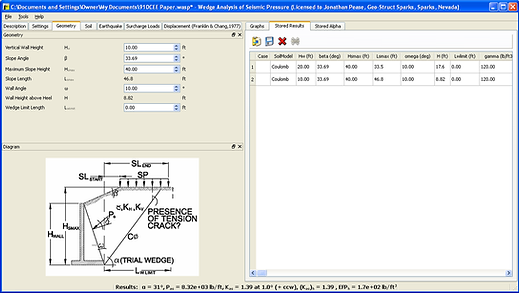
There is also a second tab, Stored Alpha, which allows you to store earth pressure versus wedge angle (Kae versus Alpha) in case you want to make graphs similar to that shown in the upper right-hand corner of the screen. Data for Stored Alpha is stored in columns rather than rows, so that it is easier to graph using conventional programs (Excel, Grapher).
Site Traffic since March 25, 2010
05164
Mononobe-Okabe Spreadsheet
Excel 2010 Spreadsheet with all the bells and whistles in case you don't want to spend the time to create and proof your own.
WASP Version 1.1 with Free Demonstration Mode
Recent Blog Entries
Questions?
If you have some interest or questions about this program or the contents of this website, please feel free to contact us in the Guestbook (under "About Us") or at jpease@rtgeo.com (my day job).
